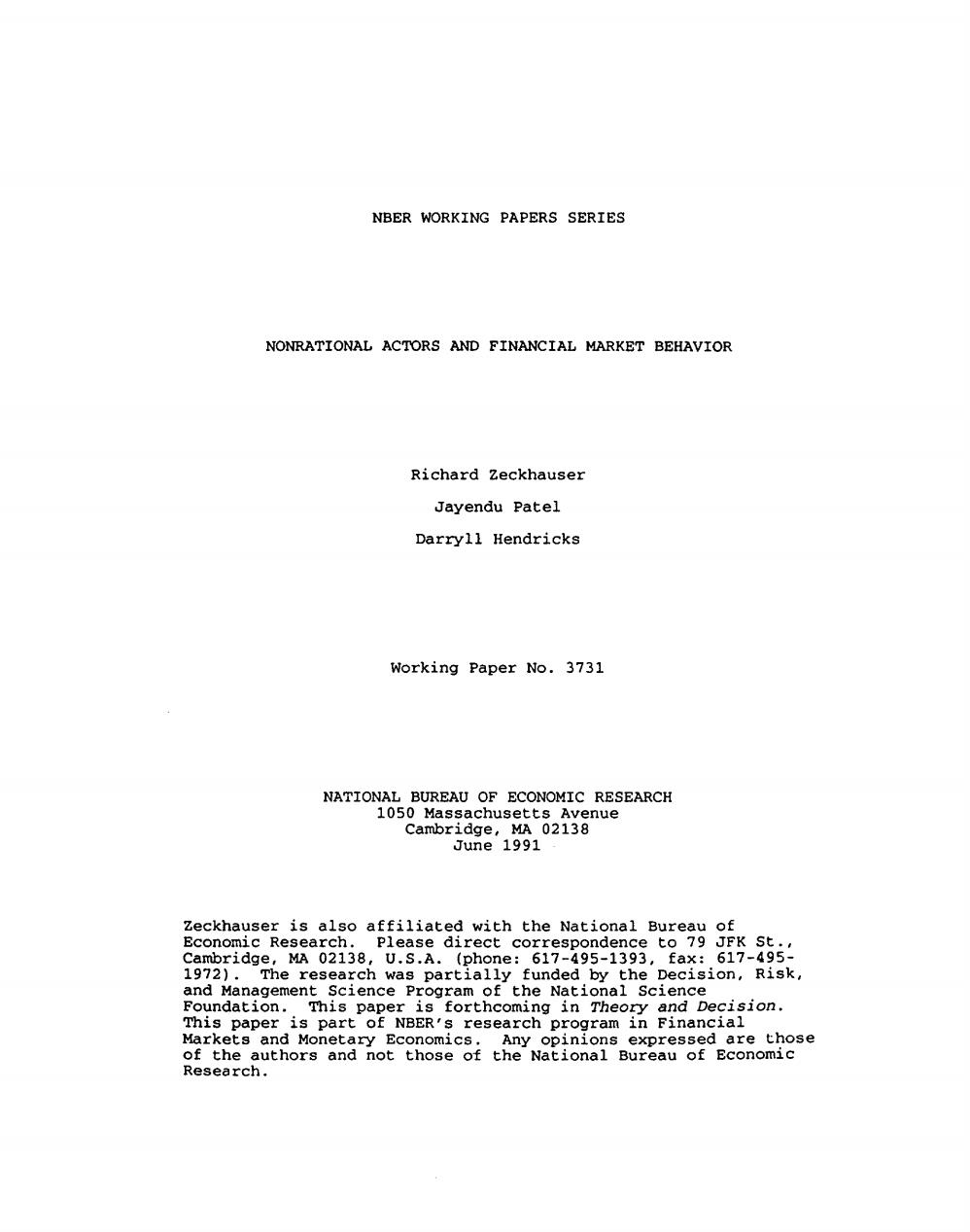
NBER WORKING PAPERS SERIES NONRATIONAL ACTORS AND FINANCIAL MARKET BEHAVIOR Richard Zeckhauser Jayendu Patel Darryll Hendricks Working Paper No.3731 NATIONAL BUREAU OF ECONOMIC RESEARCH 1050 Massachusetts Avenue Cambridge,MA 02138 June 1991 Zeckhauser is also affiliated with the National Bureau of Economic Research.Please direct correspondence to 79 JFK St., Cambridge,MA02138,U.s.A.(phone:617-495-1393,fax:617-495- 1972).The research was partially funded by the Decision,Risk, and Management Science Program of the National Science Foundation.This paper is forthcoming in Theory and Decision. This paper is part of NBER's research program in Financial Markets and Monetary Economics.Any opinions expressed are those of the authors and not those of the National Bureau of Economic Research
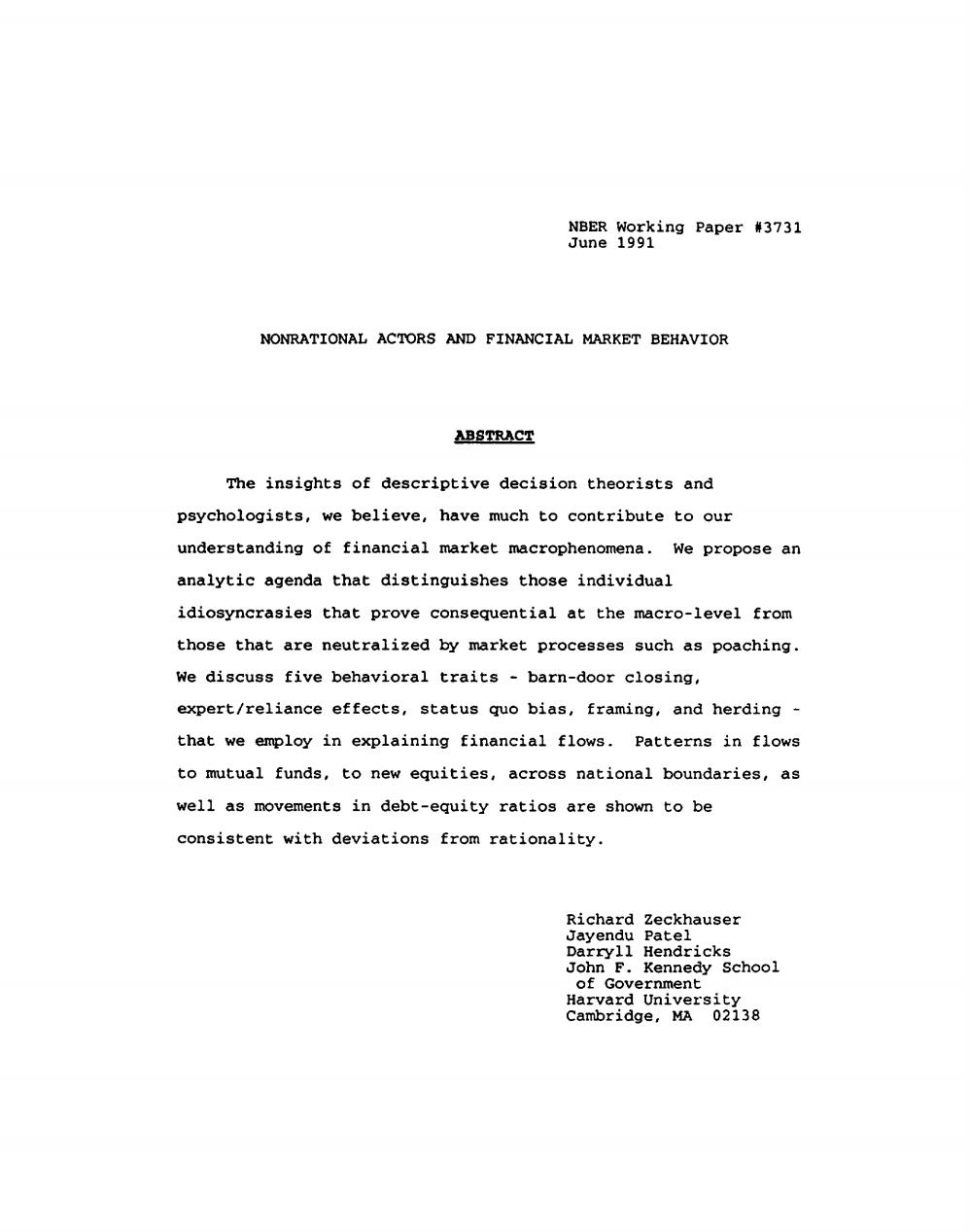
NBER Working Paper #3731 June 1991 NONRATIONAL ACTORS AND FINANCIAL MARKET BEHAVIOR ABSTRACT The insights of descriptive decision theorists and psychologists,we believe,have much to contribute to our understanding of financial market macrophenomena.We propose an analytic agenda that distinguishes those individual idiosyncrasies that prove consequential at the macro-level from those that are neutralized by market processes such as poaching. We discuss five behavioral traits barn-door closing, expert/reliance effects,status quo bias,framing,and herding that we employ in explaining financial flows.Patterns in flows to mutual funds,to new equities,across national boundaries,as well as movements in debt-equity ratios are shown to be consistent with deviations from rationality. Richard Zeckhauser Jayendu Patel Darryll Hendricks John F.Kennedy School of Government Harvard University Cambridge,MA 02138
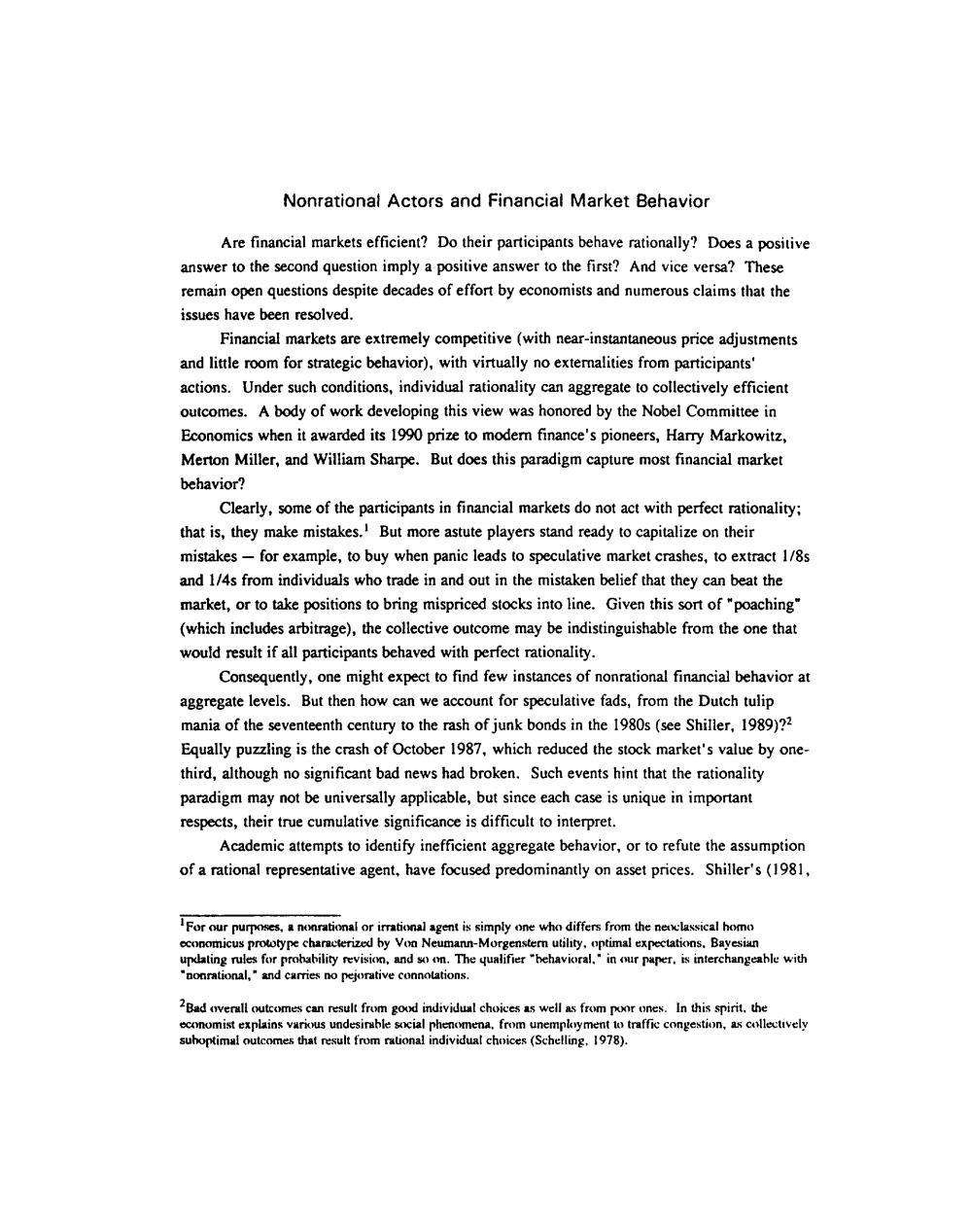
Nonrational Actors and Financial Market Behavior Are financial markets efficient?Do their participants behave rationally?Does a positive answer to the second question imply a positive answer to the first?And vice versa?These remain open questions despite decades of effort by economists and numerous claims that the issues have been resolved. Financial markets are extremely competitive (with near-instantaneous price adjustments and little room for strategic behavior),with virtually no externalities from participants' actions.Under such conditions,individual rationality can aggregate to collectively efficient outcomes.A body of work developing this view was honored by the Nobel Committee in Economics when it awarded its 1990 prize to modem finance's pioneers,Harry Markowitz, Merton Miller,and William Sharpe.But does this paradigm capture most financial market behavior? Clearly,some of the participants in financial markets do not act with perfect rationality; that is,they make mistakes.But more astute players stand ready to capitalize on their mistakes-for example,to buy when panic leads to speculative market crashes,to extract 1/8s and 1/4s from individuals who trade in and out in the mistaken belief that they can beat the market,or to take positions to bring mispriced stocks into line.Given this sort of "poaching" (which includes arbitrage),the collective outcome may be indistinguishable from the one that would result if all participants behaved with perfect rationality. Consequently,one might expect to find few instances of nonrational financial behavior at aggregate levels.But then how can we account for speculative fads,from the Dutch tulip mania of the seventeenth century to the rash of junk bonds in the 1980s (see Shiller,1989)?2 Equally puzzling is the crash of October 1987,which reduced the stock market's value by one- third,although no significant bad news had broken.Such events hint that the rationality paradigm may not be universally applicable,but since each case is unique in important respects,their true cumulative significance is difficult to interpret. Academic attempts to identify inefficient aggregate behavior,or to refute the assumption of a rational representative agent,have focused predominantly on asset prices.Shiller's(1981, For our purposes.anonrational or irrational agent is simply one who differs from the neclassical homo cconomicus prototype characterized by Von Neumann-Morgenstern utility.optimal expectations.Bayesian updating rules for probability revision,and so on.The yualifier "behavioral."in our paper.is interchangeable with "nonrational,"and carries no pejorative connotations. 2Bad overall outcomes can result from good individual choices as well as from poor ones.In this spirit.the economist explains various undesirable social phenomena.from unemplyment to traffic congestion.as collectively suboptimal outcomes that result from rational individual choices(Schelling.1978)
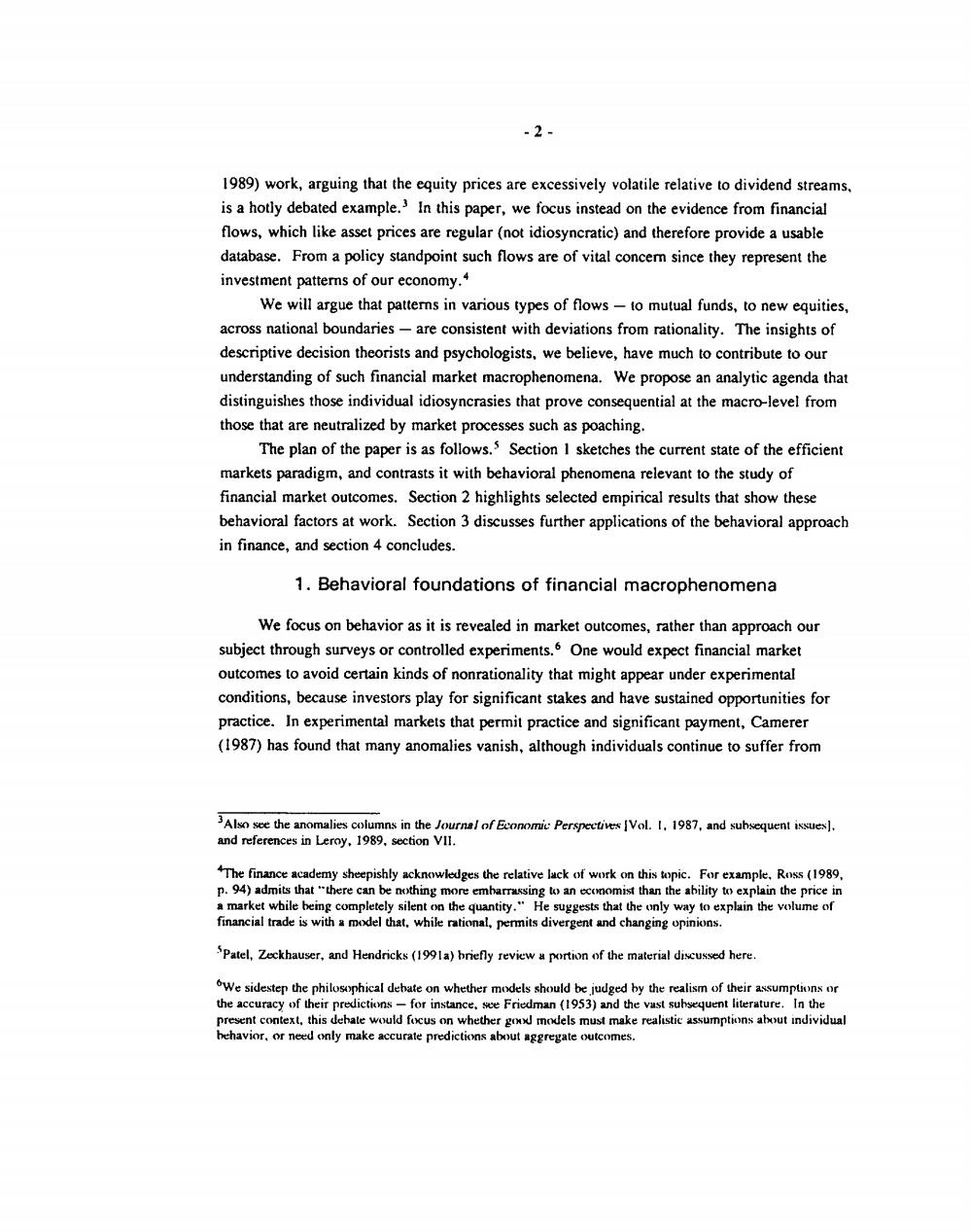
-2- 1989)work,arguing that the equity prices are excessively volatile relative to dividend streams, is a hotly debated example.3 In this paper,we focus instead on the evidence from financial flows,which like asset prices are regular(not idiosyncratic)and therefore provide a usable database.From a policy standpoint such flows are of vital concem since they represent the investment patterns of our economy.4 We will argue that patters in various types of flows-to mutual funds,to new equities, across national boundaries-are consistent with deviations from rationality.The insights of descriptive decision theorists and psychologists,we believe,have much to contribute to our understanding of such financial market macrophenomena.We propose an analytic agenda that distinguishes those individual idiosyncrasies that prove consequential at the macro-level from those that are neutralized by market processes such as poaching. The plan of the paper is as follows.5 Section I sketches the current state of the efficient markets paradigm,and contrasts it with behavioral phenomena relevant to the study of financial market outcomes.Section 2 highlights selected empirical results that show these behavioral factors at work.Section 3 discusses further applications of the behavioral approach in finance,and section 4 concludes. 1.Behavioral foundations of financial macrophenomena We focus on behavior as it is revealed in market outcomes,rather than approach our subject through surveys or controlled experiments.6 One would expect financial market outcomes to avoid certain kinds of nonrationality that might appear under experimental conditions,because investors play for significant stakes and have sustained opportunities for practice.In experimental markets that permit practice and significant payment,Camerer (1987)has found that many anomalies vanish,although individuals continue to suffer from 3Also see the anomalies columns in the Journal of Economie Perspectives Vol.1,1987,and subscquent issuesl. and references in Leroy,1989,section VIl. The finance academy sheepishly acknowledges the relative lack of work on this topic.For example,Ross (1989. p.94)admits that"there can be nothing more embarrassing to an ecoomist than the ability to explain the price in a market while being completely silent on the quantity."He suggests that the only way to explain the volume of financial trade is with a model that.while rational,permits divergent and changing opinions. SPatel,Zeckhauser,and Hendricks(1991a)briefly review a portion of the material discussed here. we sidestep the philosophical debate on whether models should be judged by the realism of their assumptions or the accuracy of their predictions-for instance.see Friedman (1953)and the vast subsequent literature.In the present context,this debate would focus on whether good models must make realistic assumptions about individual behavior.or need only make accurate predictions about aggregate outcomes
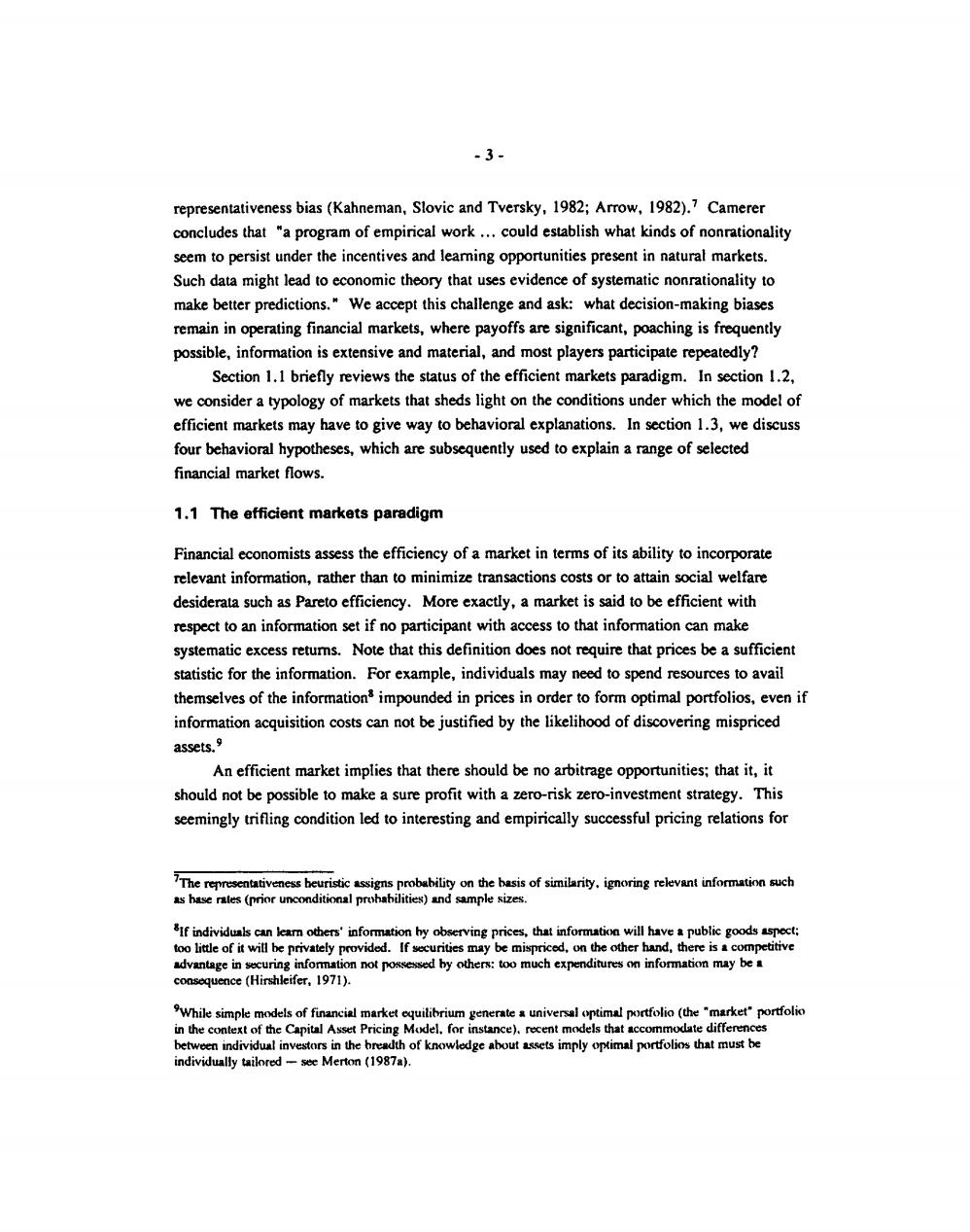
-3- representativeness bias(Kahneman,Slovic and Tversky,1982;Arrow,1982).7 Camerer concludes that "a program of empirical work...could establish what kinds of nonrationality seem to persist under the incentives and leaming opportunities present in natural markets. Such data might lead to economic theory that uses evidence of systematic nonrationality to make better predictions."We accept this challenge and ask:what decision-making biases remain in operating financial markets,where payoffs are significant,poaching is frequently possible,information is extensive and material,and most players participate repeatedly? Section 1.1 briefly reviews the status of the efficient markets paradigm.In section 1.2, we consider a typology of markets that sheds light on the conditions under which the model of efficient markets may have to give way to behavioral explanations.In section 1.3,we discuss four behavioral hypotheses,which are subsequently used to explain a range of selected financial market flows. 1.1 The efficient markets paradigm Financial economists assess the efficiency of a market in terms of its ability to incorporate relevant information,rather than to minimize transactions costs or to attain social welfare desiderata such as Pareto efficiency.More exactly,a market is said to be efficient with respect to an information set if no participant with access to that information can make systematic excess retums.Note that this definition does not require that prices be a sufficient statistic for the information.For example,individuals may need to spend resources to avail themselves of the information3 impounded in prices in order to form optimal portfolios,even if information acquisition costs can not be justified by the likelihood of discovering mispriced assets.9 An efficient market implies that there should be no arbitrage opportunities;that it,it should not be possible to make a sure profit with a zero-risk zero-investment strategy.This seemingly trifling condition led to interesting and empirically successful pricing relations for TThebeuristicssig probability onhe basis of simirityignoring relvann as hase rates (prior unconditional prohahilities)and sample sizes. SIf individuals can kam others'information by observing prices,that information will have a public goods aspect: too little of it will be privately provided.If securities may be mispriced,on the other hand,there is a competitive advantage in securing information not possessed by others:too much expenditures on information may be consequence(Hirshleifer,1971). While simple models of financialqugenerniveoimorfolio (the"etportfolio in the context of the Capital Asset Pricing Model.for instance).recent models that accommodate differences between individual investors in the breadth of knowledge about assets imply optimal portfolios that must be individually tailored see Merton (1987a)